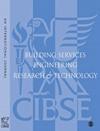The influence of different offset modes on the drainage characteristics of a double stack drainage system in a high-rise building
IF 1.8
4区 工程技术
Q3 CONSTRUCTION & BUILDING TECHNOLOGY
Building Services Engineering Research & Technology
Pub Date : 2023-06-07
DOI:10.1177/01436244231180596
引用次数: 0
Abstract
To meet the functional requirements of high-rise buildings, drainage stacks usually employ an offset pipe in the structural transfer floor. At the offset point, the flow direction changes and the air pressure fluctuates, which significantly influences the drainage system capacity and water seal effectiveness. Different offset modes have different degrees of influence on drainage characteristics. To better understand the influence of different offset modes on drainage characteristics, five different test conditions in double stack building drainage systems were established and investigated. DS1 was a standard double-stack drainage system with anti-reflux H-tube joints for every two floor levels. The remaining four systems were developed from DS1 by adopting various offset pipes (or pipe joints) on the fourth floor. DS2 adopted an S-shape offset pipe joint at the offset point. DS3 adopted double S-shape offset pipe joints. DS4 adopted a 1.0-m-long horizontal offset pipe. DS5 adopted a 1.5-m-long horizontal offset pipe. The pressure fluctuations and water seal losses were chosen as the experimental parameters to determine the maximum discharge capacity according to the Standard for Capacity Test of Vertical Pipe of the Domestic Residential Drainage System CJJ/T 245. The experimental results demonstrated that the installation of offset pipes (or pipe joints) contributed to the abrupt positive pressure and severe water seal losses at the position where flow direction shifted. As the length of the offset pipe increased, the positive pressure was more severe, and maximum discharge capacity was minor. The relationships among the maximum discharge rate, pressure fluctuation limits, and water seal losses are discussed. Lastly, a nondimensional analysis was adopted to understand the relationship between water seal losses and pressure limit values under different discharge rates for current test facilities. Practical application: Pipe offset has the potential to influence a drainage system discharge capacity. As the length of the horizontal offset pipe increases, the discharge capacity will decrease. In the actual design, the length of the offset pipe section should be reduced and this study demonstrates that the application of S-shape offset pipe joints is an efficient solution.不同偏移方式对高层建筑双层排水系统排水特性的影响
为了满足高层建筑的功能要求,排水立管通常在结构转换层采用偏置管。在偏移点处,流动方向发生变化,空气压力波动,这对排水系统的容量和水封效果产生了显著影响。不同的偏移方式对排水特性有不同程度的影响。为了更好地了解不同偏移模式对排水特性的影响,建立并研究了双层建筑排水系统的五种不同试验条件。DS1是一种标准的双层排水系统,每两层楼都有防回流H型管接头。剩下的四个系统是在DS1的基础上开发的,在四楼采用了各种偏置管(或管接头)。DS2在偏移点采用S型偏移管接头。DS3采用双S型偏置管接头。DS4采用了1.0米长的水平偏置管。DS5采用1.5米长的水平偏置管。根据《生活排水系统立管容量试验标准》CJJ/T 245,选取压力波动和水封损失作为试验参数,确定最大排水量。实验结果表明,在流动方向发生变化的位置,安装偏置管(或管接头)会导致突然的正压和严重的水封损失。随着偏置管长度的增加,正压越大,最大泄流量越小。讨论了最大流量、压力波动极限和水封损失之间的关系。最后,采用无量纲分析来了解当前试验设施在不同流量下水封损失与压力极限值之间的关系。实际应用:管道偏移有可能影响排水系统的排水能力。随着水平偏置管长度的增加,排放能力将降低。在实际设计中,应减少偏置管段的长度,本研究表明,应用S形偏置管接头是一种有效的解决方案。
本文章由计算机程序翻译,如有差异,请以英文原文为准。
求助全文
约1分钟内获得全文
求助全文
来源期刊

Building Services Engineering Research & Technology
工程技术-结构与建筑技术
CiteScore
4.30
自引率
5.90%
发文量
38
审稿时长
>12 weeks
期刊介绍:
Building Services Engineering Research & Technology is one of the foremost, international peer reviewed journals that publishes the highest quality original research relevant to today’s Built Environment. Published in conjunction with CIBSE, this impressive journal reports on the latest research providing you with an invaluable guide to recent developments in the field.
 求助内容:
求助内容: 应助结果提醒方式:
应助结果提醒方式:


